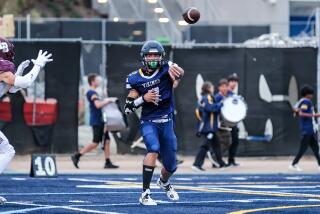Prop. 48--Windfall for JCs? : Athletes May Opt for 2-Year Programs
- Share via
Junior college football coaches learn quickly that there are few guarantees in their jobs--particularly in recruiting, the lifeblood of most successful programs. Unlike their counterparts at four-year schools, where letters of intent signed by recruits are binding, JC coaches never know who will make their rosters until the first day of practice during late summer.
So, it is understandable why many coaches are taking a wait-and-see attitude about a predicted wave of talent that is supposed to roll through their programs during the next few years courtesy of the National Collegiate Athletic Assn.
Last year, the NCAA ruled that Division II schools no longer could employ academic restrictions less stringent than those adopted by Division I schools. The legislation, which takes effect Aug. 1, makes admissions standards for athletes uniform in both divisions.
In the past few years, some Division II schools have benefitted from Proposition 48, which requires freshmen athletes to score a combined 700 on the Scholastic Aptitude Test and maintain a C average in core classes. An athlete who fails to meet Prop. 48 standards still can accept a scholarship to a Division I school but is not allowed to play or practice with the team and loses a year of eligibility.
Now that entrance standards are the same, however, it is expected that many athletes will opt for junior colleges and transfer one or two years later.
“It’s a boon to the community colleges because a lot of kids would choose that route rather than lose a year of eligibility,” said Bob Burt, football coach at Cal State Northridge.
Burt knows firsthand about the benefit of the old rules, which helped the Matadors land Albert Fann out of Cleveland High last year. Fann, a 6-2, 215-pound running back, was initially ineligible to play for many of the Division I schools that recruited him because of inadequate grades. Instead of attending a junior college and possibly transferring to a Division I school after two seasons, Fann chose instead to enroll at Northridge, where he rushed for 822 yards and led Division II in kickoff return average (29.3) last season.
Fann said the new rule will affect the decisions of many high school players who, had they failed to qualify for admission to Division I schools, might have chosen a Division II school instead.
“Now it doesn’t matter what you have because you’re not going to be able to get into a four-year college anyway,” Fann said, referring to grades. “Kids are going to say, ‘Well, I might as well go for the big time and go to a JC and transfer to a Division I school.’ ”
The reaction is mixed among junior college coaches. Many believe that there may be an initial impact on their programs while others do not foresee much change.
“I think there’s going to be a period of time where the community colleges are going to get a higher quality athlete,” Glendale Coach Jim Sartoris said.
Valley Coach Chuck Ferrero agrees with Sartoris, but other coaches are not quite as certain about the impact of the new rules.
“There will be some effect, but I don’t think it’s going to make a major difference,” Pierce Coach Bob Enger said. “We may get a couple of kids we may not have normally gotten in the past but not too many.”
Santa Monica Coach Ralph Vidal said coaches can expect to land a few players, but “there are some kids you’re never going to get.”
Last year, Vidal said he tried to recruit a pair of talented defensive backs who failed to meet Prop. 48 standards. They decided instead to walk on at Division I schools.
“They gave up their first year of eligibility because they just didn’t want to go to a community college,” Vidal said.
While junior college coaches must wait until summer to see how the new rule affects player turnout, the impact already can be seen in this year’s recruiting classes at Cal State Northridge and Cal Lutheran--Division II schools that previously concentrated their efforts on high school players.
At Northridge, Burt signed a school-record 23 junior college players. Cal Lutheran Coach Bob Shoup signed 14 junior college players, the most he has recruited.
“Our attempt this spring was to balance the recruiting up with more older kids,” Shoup said. “I think we’ll be doing the same kind of thing in the future.”
Sartoris does not expect the talent flow to junior college programs to last for more than a few years. By then, he said, athletes will have a better understanding of--and commitment to--the standards they must meet to qualify for Division I scholarships.
“Eventually, high school kids are going to adjust and take the right classes and take the SAT,” Sartoris said. “But for a few years, I think we’ll see more and more quality athletes at the community colleges and the level in football and all sports is going to go up.”
More to Read
Get our high school sports newsletter
Prep Rally is devoted to the SoCal high school sports experience, bringing you scores, stories and a behind-the-scenes look at what makes prep sports so popular.
You may occasionally receive promotional content from the Los Angeles Times.







